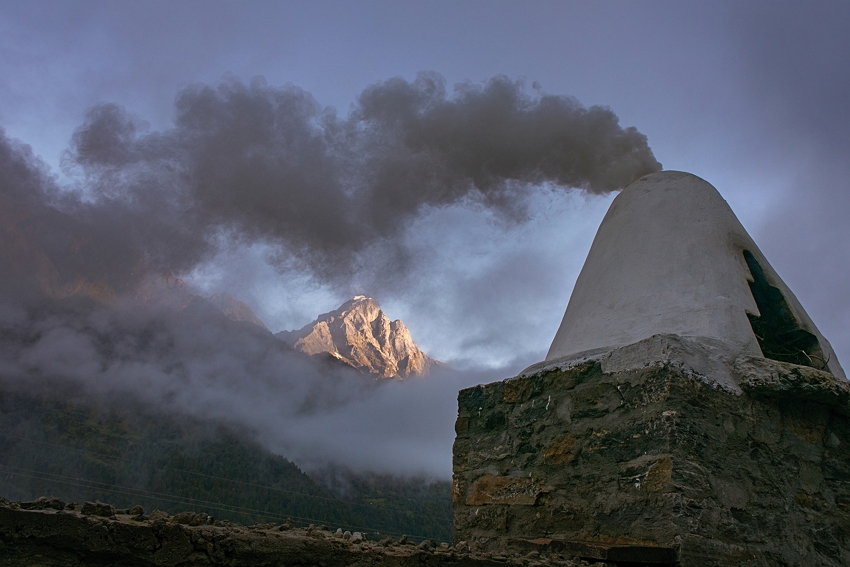
Sherpas piously recite the Padmasambhava Mantra every morning. They burn incense during the recitation, which marks the beginning of each day. Shown in the background here is Phari Lapcha, one of the holy mountains. (photo by Tony Lee)
I am a photographer who loves outdoor activities. I developed an interest in sport, as well as in mountain hiking, after moving to Canada at the age of 13.
Located on the border between Nepal and China, Everest—the world’s highest mountain—is an earthly paradise that many people dream about. Of course it is also one of those places I feel I have to visit before I die.

On the way to Everest’s summit, “Icefall Doctors” (local Sherpas responsible for making the Everest routes secure) carry out prayer rituals before traveling from the Base Camp to Camp Two through the dangerous Khumbu Icefall. (photo by Tony Lee)
Mt. Everest was conquered for the first time in 1953, a momentous event that brought immediate fame to the place and the Sherpa people. At that time the Sherpa villages in Nepal were still primeval, combining traditional agrarian and nomadic ways of life.
Since 1953, within a space of just 67 years, visitors and non-governmental organizations from all over the world have arrived on the scene, enabling the local Sherpas to subsist entirely on the tourist industry. However, despite the economic gains derived from tourism, the Sherpas’ traditional culture has been severely impacted.
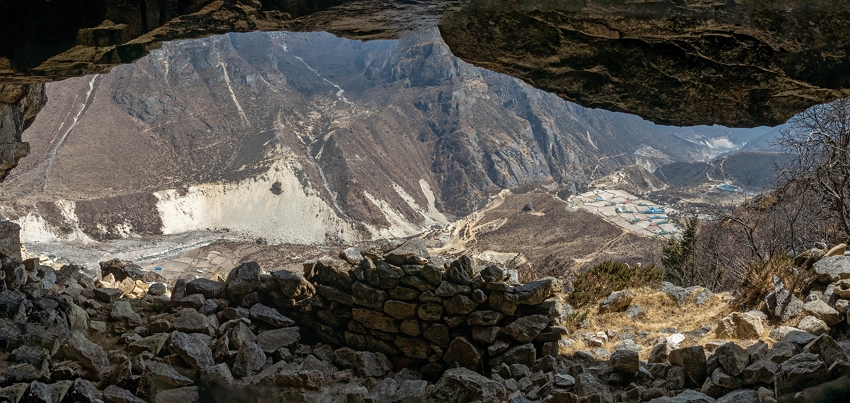
Legend has it that Guru Rinpoche sought enlightenment in this cave, which overlooked a wilderness as recently as four centuries ago. Because of their religious faith, more and more people arrived to live in the area below the cave, giving rise to the three villages we see today. (photo by Tony Lee)
Five centuries ago, the Sherpas’ ancestors—a group of some 50 people with a large herd of yaks—fled to Lhasa from their war-ravaged home in today’s Garzê Tibetan Autonomous Prefecture in China’s Sichuan Province. They hoped to settle permanently in this holy and peaceful place.
However, in 1531-1533, when invading Muslim troops arrived on the outskirts of Lhasa, these people fled again to what is today China’s border county of Tingri. Because their yaks destroyed crops, they were plunged into conflicts with local people.
Among the Sherpa ancestors there was a hunter called Kira Gombu Doje. Having spotted a Himalayan musk deer in the ice-clad mountains, he followed it with his hound. Never did he guess that the deer would lead them over one steep mountain after another to Khumbu, a pristine place full of spirituality.
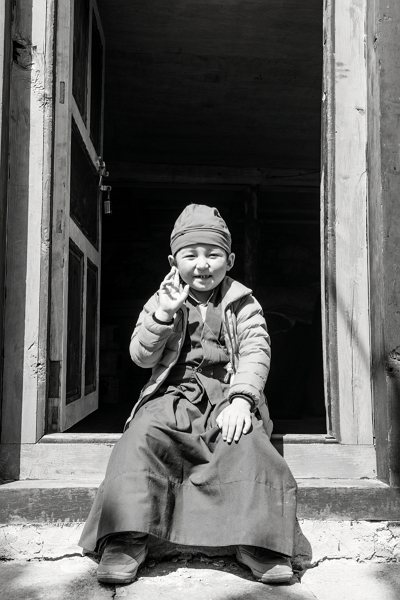
The six-year-old child pictured here is the reincarnation of the rinpoche of the village of Thame, Nawang Tsering Dodub. (photo by Tony Lee)
Even today, the Sherpas believe that the musk deer that showed their ancestors the way to Nepal was an incarnation of the local mountain deity, Khumbu Yül-Lha. The Nepali region of Khumbu, where many Sherpas live, also derives its name from this legend.
The Sherpas are pious adherents of Tibetan Buddhism, and religion plays a significant role in Sherpa culture. According to Tibetan Buddhist scriptures circulated in the region, Khumbu was one of 108 holy places tucked away between Tibet and the Himalayas.
There is an ancient legend among the Sherpas that Padmasambhava, or Guru Rinpoche (the deity who gave rise to Tibetan Buddhism), traveled from Tibet to spend some time in Nangpa La. When he entered the Khumbu region he flew into a huge bell-shaped cave, where he subjected himself to austere spiritual practices.
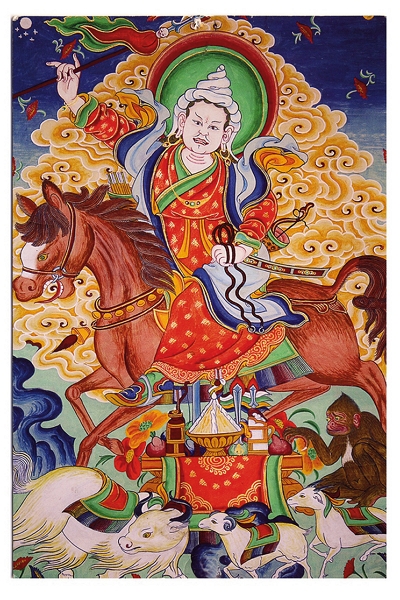
Khumbila (Khumbu Yül-Lha) is the patron deity of the Sherpas in the Khumbu region. (photo by Tony Lee)
The locals venerated him and took meticulous care of him. When Guru Rinpoche had achieved his aim of enlightenment and was about to leave, he wanted to give something to the villagers. He asked: “Would you like me to build in your country a Buddhist pagoda, where wisdom abides? Or would you like me to exercise my divine power and protect this pristine place by means of high mountains and snow?” The locals chose the latter.
According to the scriptures, Guru Rinpoche carried out his religious study in many of the caves on the precipices in Khumbu, one of which is photographed here. Over the past 400 years, many lamas and rinpoches have also come here to pursue their spiritual enlightenment.
For the Sherpas, the rainy season coincides with the low season for tourism. Owing to the absence of visitors, many locals are able to enjoy their family lives to the fullest. Therefore, only during the wet season can we gain a deeper insight into how the Sherpas really live.

This deity is the god of longevity, Mi Tsering. During the Dumji Festival, his playful clowning brings merriment to the attendees. It is said that those who are caught and teased by him will lead a long and blessed life. (photo by Tony Lee)
In fact the Sherpas are particularly busy from June to August every year because the rainy season witnesses two special events, the more important one being the Dumji Festival, which features ritualistic offerings. This festival, inaugurated some four centuries ago, celebrates the birth of Padmasambhava on the tenth day of the fifth month of the Tibetan calendar (the month of the monkey). In the Gregorian calendar, it falls between late June and early July.
The Dumji Festival is known for its highly complex rituals. There are various vajra dances. During the interval the deity of longevity, Mi Tsering, arrives to confer a jolly mood upon the attendees. And then there are annual rites of exorcism, where masked lamas, who represent the deities, shoot flaming arrows at piles of offerings that symbolize ill fortune and evil spirits.
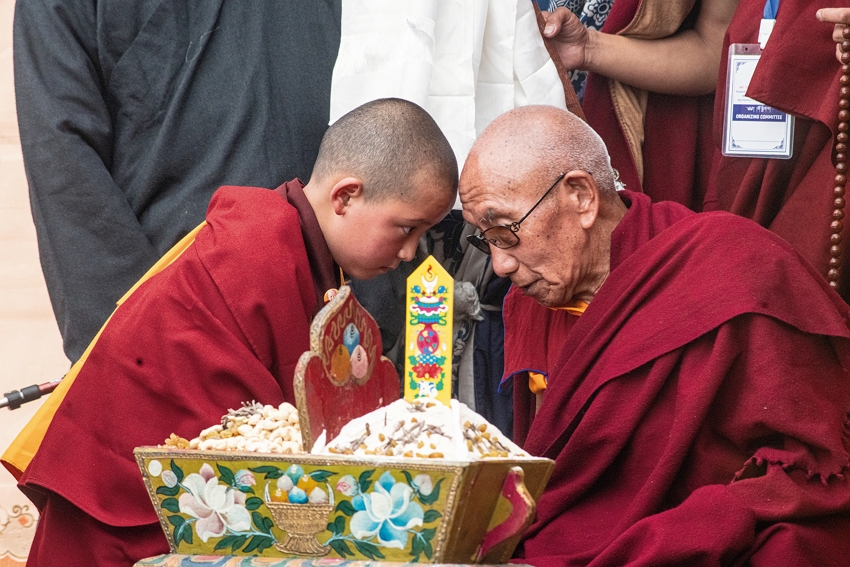
Ngawang Tenzing Zangpo Rinpoche (right), of Tengboche Monastery in Khumbu, spent three days and nights crossing the mountains on a palanquin in order to preside over the investiture of the reincarnate Thame rinpoche, Nwang Shedrup Sherpa. (photo by Tony Lee)
What is most touching for me is that on this day, all people are treated equally regardless of their gender, age, religion, ethnicity and social class. They pray, dine, give and receive as one community. Everyone endeavors to cultivate humility, and order and politeness reign throughout the place.
The Sherpas are not only mountain guides. Their home in the Himalayas is also a place where culture and etiquette bloom.











